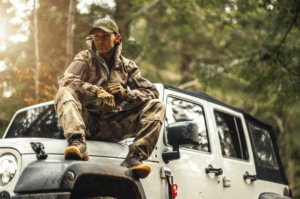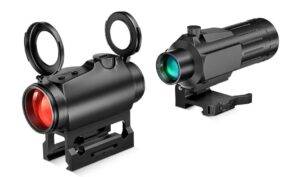
If you’re an environmentally savvy outdoors person, you will know all about the damage caused by the grey squirrel (Sciurus carolinensis) and wild rabbit (sylvilagus spp.). They look cute, but they are a downright nuisances and it’s right to categorize them as rodents and garden pests.
When you live in an urban area, you will have maybe felt the urge to use rats as target practice when you want to learn how to hunt with a slingshot. The places where we live present the slingshot hunter with delicious and dirty rodents or other pest animals every day. You can find reliable reviews of hunting gear at PointOptics, to make sure you get all the info you’ll need.
If you live in a rural area or close to a park, then squirrels make very inviting targets, because the best thing about taking down a squirrel with a slingshot is they make for very tasty eating. This is part of the slingshot shooting etiquette: eat it or rid the neighborhood of it, but never target a critter for fun. You can use binoculars with cameras to make your search easier, you can view them here.
Best Animals to Hunt with a Slingshot
If you have in-depth knowledge about which bird species – in your garden and in the wild – are territorial and invasive then if you see one, run for your slingshot and let fly with your ammo of choice. Birds in the wild you can get a meal from are waterfowl, wild turkey, ducks, wood pigeons, and pheasant. Slingshot etiquette means leave all other winged creatures alone.
Animals to avoid targeting when you are hunting with a slingshot are:
- Wild pig
- Deer
- Gators
- Bears
- Cat predators
- Endangered species
- Domesticated pets
This is because only the most experienced and professional hunters are skilled enough to take down a target like a wild pig or deer with a slingshot. You’ll just be wasting your ammo if you attempt to hunt one of these animals as a beginner slingshot hunter. Even worse, you could injure the animal and scare it off so that it can’t be located and dispatched humanely. Or you could enrage it.
The best piece of advice any hunter can give someone who’s learning to hunt with a slingshot is: If you aren’t sure whether the animal falls within the “eat it or rid the neighborhood of it” category, it’s best to aim for something else.

Why Should I Learn How to Hunt with a Slingshot?
Hunters have been using strips of leather to project a missile further for millennia. It was only with the manufacture of rubber in the 19th century when the commonly used catapult morphed into the slingshot we use to hunt today. Becoming an expert in the hunting methods used by our ancestors is an important skill to learn for survival. No matter what happens, if you can lay your hands on a strip of leather, a forked branch, and a stone, you’ll be alright.
Slingshot information
Firing off a shot using a slingshot is a far slower projectile when compared to a rifle or shotgun. It also needs the skill and strength to deliver a missile with enough energy to take down an animal. It’s best to aim for small game at close range; accuracy and proximity are crucial factors to hunting with a slingshot successfully.
If you miss and injure the animal instead, always carry a club of some sort with you so you can go up close and finish off the animal with a blow. Because slingshot hunting involves a lot of sitting quietly in trees or behind bushes, it’s best to leave your hunting dog behind for this trip.
Give yourself a thorough training with your slingshot at home before venturing outdoors. Using homemade targets and items, don’t stop practicing until your accuracy means you can hit a target of one inch across from ten yards or further.
Which Slingshot is Best?

There is a huge variety of slingshots on the market. The best slingshot to use for hunting is the one you have a feel for and use all the time. If your track record of hits with a basic slingshot is good, don’t be swayed into changing to a high-tech model just because it looks better. Any slingshot is lethal when the hunter has experience with it.
You can make your own slingshot with a few basic items you have laying around the house. If this is too time-consuming and you want to get right down to practice this week, look for any model that has the following features:
- Highest quality elastic bands
- Wrist support (for bracing against your forearm)
- Optional fork extension
The drawback is that the more high-tech and fancy your slingshot is, the more you will end up paying for it.
What Ammo Should I Use When Hunting with a Slingshot?
You can shoot anything from a slingshot: if you are practicing in your yard with a target on a board, then marbles, small stones, and even squash balls can be used. Before starting, however, you must wear eye protection of some kind. Even if your target is more than 10 feet away from you, ricocheting can cause projectiles to fly up.
If you don’t have protective glasses to wear, a pair of sunglasses would be better than nothing at all. Look in the garden shed, and use the ones kept for lawnmowing.
If you are unsure over what ammo to place in your pouch, remember that pretty much anything can be used for practice aiming, shooting and the high-quality ammo should be kept for the real thing when hunting outdoors.

Glass Marbles: These are ideal for practice, but are too light for real hunting. Because they are made from glass, keep your protective eyewear on.
Golf balls: These are dangerous for practicing on hard targets because of the ricochet. They are best used on soft targets like grass and sand.
Rocks/Stones: The laws of physics mean that the heavier the stone, the further it will travel with momentum according to the force behind it, and the harder it will hit.
Steel Balls/Steel Bearings: The perfect ammo; smooth, heavy, and hit hard. When you are hunting with a slingshot, use steel balls of around 0.5. Anything with a smaller diameter will not be heavy enough for a clean kill.
Lead Ball: These are even better for sling shot hunting than steel balls or bearings. This is because lead is denser, so it hits harder and flies more accurately. The only drawback to using this ammo when hunting or practicing is the price, and the cost to the environment.
Once you’ve shot a lead ball, it warps on impact, and because spherical shapes are the best projectiles, a misshapen lead ball is no good. In addition to this, if lead is left in the ground, it will have a negative environmental impact. Always wash your hands after touching lead balls. If you want to buy a few lead balls just to see how they handle, the calibers to get are .38 up to .45.
Hex nuts: They aren’t spherical, which is a drawback over longer distances, but they’re heavy and cheap. Choose ones around 8 to 12 grams.

Image used courtesy of the Slingshot Community Forum
Best Slingshot Hunting Tips
Practice will make your first hunting trip with a slingshot a far better experience; this cannot be stressed enough. Even when you think you have the technique down, you can’t judge your level of expertise until you’ve pitted yourself against the speed and agility of a squirrel or rabbit.
You can’t consider yourself adept at hunting with a slingshot until you can hit the head of your target animal, and not the body. Work at your stealth techniques, so you can get in as close as possible. If you are hunting from the vantage point of an oak tree, practice your patience and maintaining silence for a considerable while.
Keeping your eyes peeled for small movements and rustling. Any small rodent-type animal will stop and pause before trying to make a run for it. If you want to be able to hit a target on the run, you need to practice taking such shots at home as well.
- Always Aim for the Head
Squirrels are hardy and tough, the best place to hit them is the head. It’s humane and effective.
- Squirrels and Rabbits Make Less Noise
If you have only been out after deer with a rifle before, prepare yourself for something very different. These make less noise and move faster.
- Squirrels Love Trees, Rabbits Love Fields and Hillocks
Get to know your local hunting spots and park yourself there at feeding times. Squirrels and rabbits aren’t the sharpest crayons in the box, so these creatures of habit like to hang out in the locations they are used to.
Slingshot Use
- While holding the base with your dominate hand, place the ammo in the pouch center with your other hand.
- Hold the ammo ball in place using your fingers – not too tightly.
- Grip the handle with dominant hand and pull loaded pouch back with other hand.
- When you shoot and release, you should allow the slingshot to jerk forward.
- You can hold the fork in a horizontal or vertical position.
- Keep your legs apart to give yourself balance, and turn your torso sideways toward the target.
- Always check before you release that there is nothing else in the way of you and the target.

Image used courtesy of Simple Shot Academy
With these basic slingshot principles of practice and hunting etiquette, you should be able to master the art of slingshot hunting, and eat well too.







